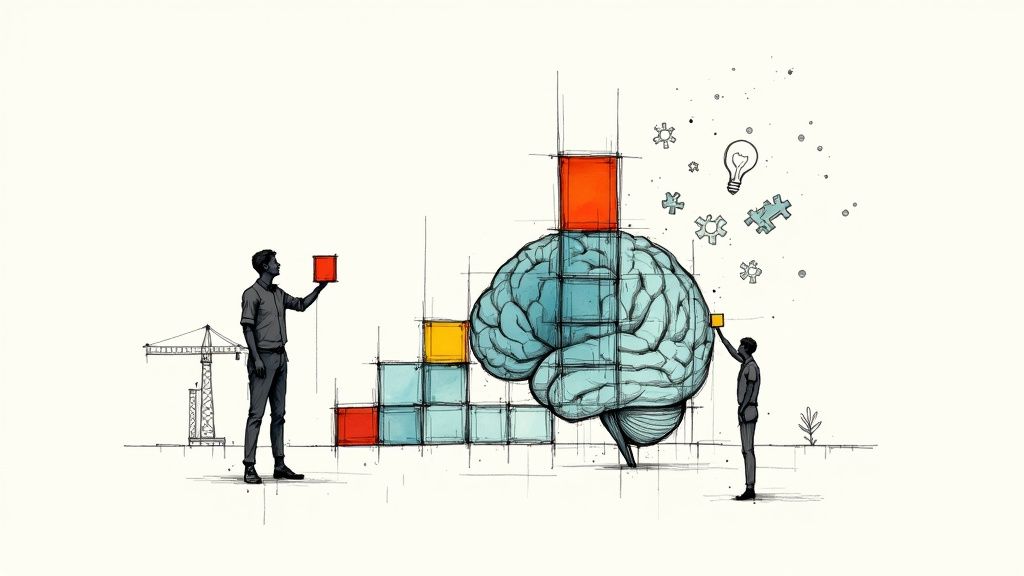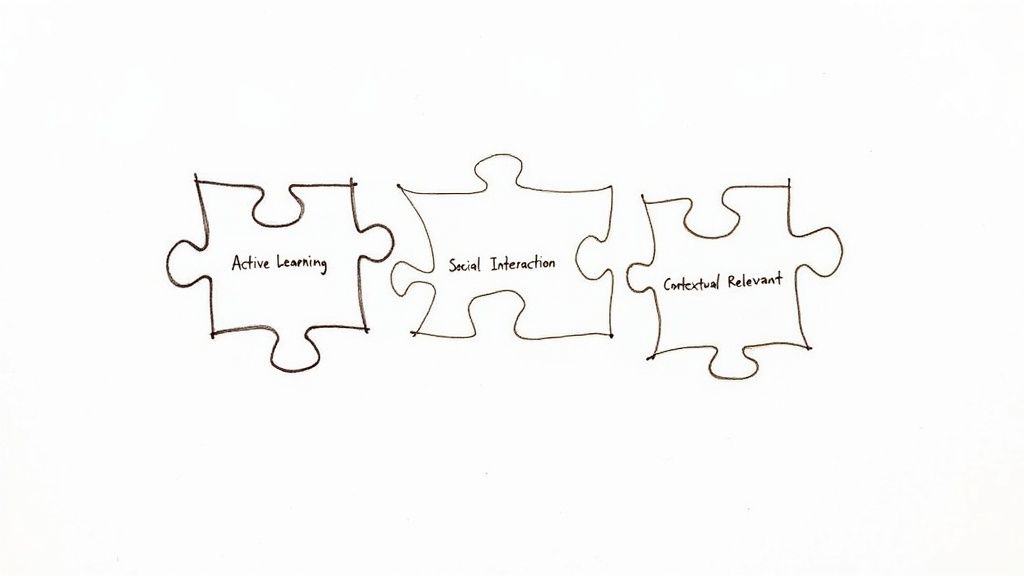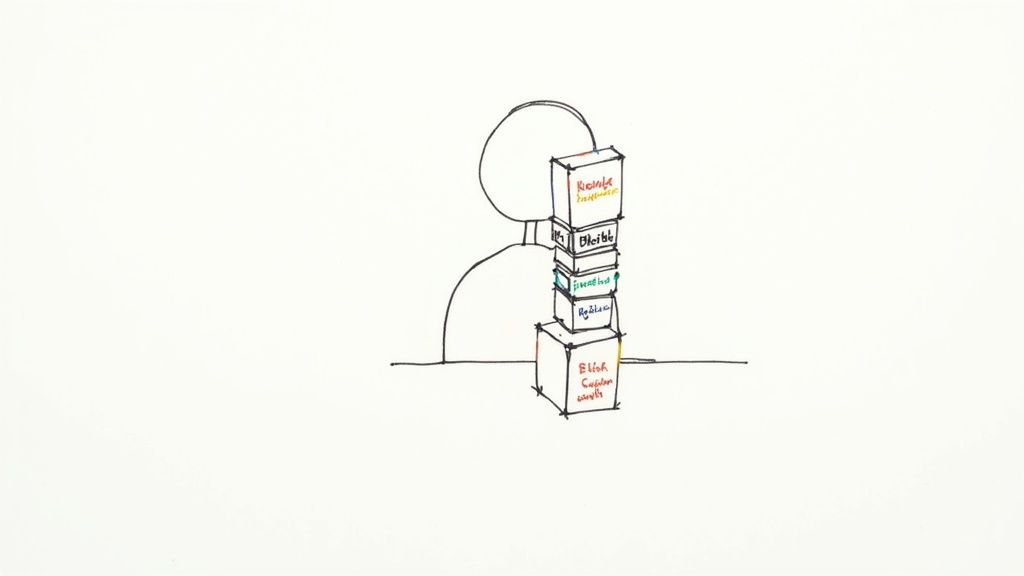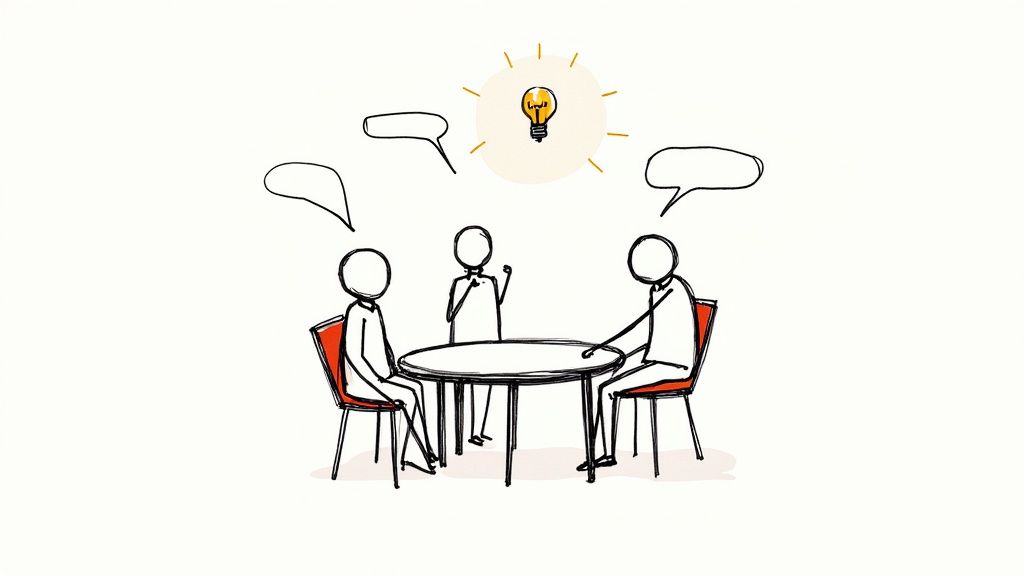
Constructivist learning theory is a simple but powerful idea: we learn best by doing, not just by listening. It suggests that we are all active builders of our own knowledge, piecing together new experiences with what we already know. Think of it like building with LEGOs—you use the bricks you have to create something new.
Let’s ditch the textbook jargon for a moment. At its heart, constructivism is about learners being the architects of their own understanding. Instead of just memorizing facts spoon-fed by a teacher, learners get their hands dirty. They explore, they question, and they connect the dots in a way that’s meaningful to them.
It's the difference between being handed a completed map and being given a compass and a destination. The person with the compass has to figure out the path, creating a much deeper and more personal connection to the journey and the landscape.
This approach completely flips the script on the traditional classroom model. The spotlight moves from the teacher as the "sage on the stage" to the student as the active discoverer. This shift is crucial for today's instructional designers, especially those using tools like the Articulate Suite or Adobe Captivate. Their job isn't just to present information; it's to design engaging experiences that spark curiosity and encourage problem-solving.
The core principle here is that learning is an active process. We are constantly building upon our existing mental frameworks, or "schemas." This isn't a radical new idea; in fact, a foundational concept in education states, "The most important factor influencing learning is what the learner already knows." If you want to dive deeper, you can explore more insights about this foundational principle and see just how much it has shaped modern teaching.
This idea is often broken down into three key pillars that support the entire theory.

As the diagram shows, genuine learning happens at the intersection of active participation, social collaboration, and real-world context.
So, what does this old theory have to do with designing a corporate training program in the 21st century? Everything. Effective learning has never been about information dumps. It’s about creating an environment where people can roll up their sleeves, work together, and apply new concepts to the challenges they face every day.
This is exactly where modern learning technologies shine:
Ultimately, constructivism gives us the "why" behind so many modern instructional design trends. It's the philosophy that grounds our use of technology in a proven, learner-first approach.
To really see the difference, it helps to put the two approaches side-by-side.
This table offers a quick snapshot of how the constructivist model breaks away from the top-down, traditional way of teaching.
Seeing it laid out like this makes it clear that the goal isn't just to get learners to remember facts, but to equip them with the ability to think critically and solve problems.
To really get what constructivist learning theory is all about, we have to look past the simple idea of "learning by doing." It's more like building a house. You don't just start throwing bricks in a pile; you need a solid foundation and a clear blueprint. Constructivism has four key pillars that explain how we actually build meaningful, lasting knowledge.

These aren’t just stuffy academic ideas. They're the real-world mechanics of how our brains connect new information to what we already know. It’s why getting your hands dirty with a project teaches you so much more than sitting through a two-hour lecture.
First things first: learning isn't a passive activity. People aren't empty buckets waiting for us to pour knowledge into their heads. They are active builders, constantly taking new information and experiences and figuring out how to fit them into their existing view of the world.
Think about two people learning project management. One reads a textbook from front to back. The other is put in charge of planning a small community fundraiser. Who do you think really gets it? The person juggling budgets, deadlines, and volunteers is actively constructing a much deeper understanding of how it all works.
This is exactly why interactive authoring tools like the Articulate Suite or Adobe Captivate are so powerful in modern instructional design. They enable the creation of experiences that make the learner do something—make a choice, see a result—and actively build their own comprehension.
We don't build knowledge alone in a dark room. Constructivism points out that learning is fundamentally social. It’s shaped by our conversations, debates, and collaborations with classmates, mentors, and colleagues.
When people share their ideas, they get exposed to different viewpoints that challenge and strengthen their own. It’s the reason modern LMS and LXP platforms are evolving beyond simple course repositories to include social forums, peer review features, and team projects. That back-and-forth is where the real learning magic happens.
Learning is an experience. Everything else is just information.—Albert Einstein
This social piece helps us move from seeing things one way to appreciating a much more complex and nuanced reality.
The third pillar is all about relevance. Learning sticks when it's anchored to a real-world context. Abstract facts and figures are easy to forget, but when you tie knowledge to a problem you actually need to solve, it has a way of staying with you.
For example, teaching customer service with a slide deck is one thing. Putting trainees into role-playing scenarios where they deal with simulated angry customers is another thing entirely. The context makes the training meaningful and useful from day one. This simple idea is at the heart of many instructional design best practices.
This is why so many of us are now designing with:
Finally, we have to remember that nobody comes to a learning experience as a blank slate. Everything new we learn is filtered through what we already know and believe. Our past experiences are the foundation for all future learning.
A smart instructional designer or trainer gets this. They'll start a session by asking a question or doing a quick activity to get people thinking about what they already know about the topic. This simple step helps build a bridge from the old to the new, making the new information much easier to grasp.
It’s the same logic behind an AI-powered LXP that first assesses a user's skill level before suggesting a learning path. You have to know where someone is starting from to help them get where they need to go. Together, these four principles give us a powerful framework for creating learning that actually works.
Every big idea has its pioneers, and for constructivism, the story really comes down to two brilliant minds from different corners of the world: Jean Piaget and Lev Vygotsky. They never actually worked together, but their unique perspectives created a powerful one-two punch that forms the foundation of the theory today. One looked inward at the mind, while the other looked outward toward society.
Their work started making waves in educational psychology back in the 1920s with Jean Piaget's groundbreaking ideas. Lev Vygotsky's theories followed a bit later in the 20th century, though his focus on social learning really took off globally after his works were translated in the 1970s. It's fascinating to see how their timelines intersected and how their contributions built on each other, even from a distance.
Jean Piaget, a Swiss psychologist, had this wonderful view of children as "little scientists." He pictured them constantly poking, prodding, and experimenting with the world around them, building their own understanding through pure trial and error. His take on the theory is often called cognitive constructivism because it’s all about what’s happening inside our heads.
To explain this process, Piaget gave us two key concepts: assimilation and accommodation.
Think of a toddler who has a mental model for "doggy"—it’s got four legs, fur, and a tail. The first time they see a horse, they might point and yell, "Doggy!" That's assimilation in action. They're trying to make this new creature fit their existing "doggy" framework.
But then, a parent steps in and says, "No, sweetie, that's a horse. See how big it is? It says 'neigh.'" Now the child’s brain has to adjust. They can't just stuff "horse" into the "doggy" box anymore; they need to create a whole new category. That mental shift is accommodation. Through this simple, personal discovery, the child actively builds a more accurate picture of the world.
While Piaget was zeroed in on individual discovery, the Russian psychologist Lev Vygotsky saw things differently. He argued that learning isn't a solo mission—it's a team sport. His theory, known as social constructivism, puts community, culture, and interaction right at the heart of how we build knowledge.
Vygotsky believed we learn best with help from a "More Knowledgeable Other" (MKO). This could be anyone—a teacher, a classmate who gets it, or even a parent. He came up with a brilliant concept to describe this dynamic.
The Zone of Proximal Development (ZPD)This is the magic space between what a learner can do completely on their own and what they can achieve with a bit of help. It’s where the real learning happens.
Think about learning to ride a bike. If you're left to your own devices, you'll probably just fall over and over again. But with a parent holding the seat, giving you that little bit of balance and encouragement, you suddenly get it. That support is the bridge across your ZPD. They aren't riding the bike for you; they're just giving you the scaffold you need to build the skill yourself.
Together, Piaget and Vygotsky give us the full picture. Piaget shows us the internal gears turning as our minds make sense of things, while Vygotsky reminds us that we rarely do it alone.
The real magic happens when you take a powerful learning theory and see what it can do with today’s technology. That's exactly what's happening with constructivism. Instructional designers are moving beyond just classroom discussions and are building dynamic, digital experiences that truly empower people to build their own knowledge.
It’s less about just delivering content and more about creating guided playgrounds where learners can tinker, explore, and even fail safely.

From corporate training modules to full-blown online courses, the tools we have now are incredibly well-suited for this kind of hands-on approach. The goal is to create environments where learners can connect what they’re learning to real-world challenges they actually face.
This is why getting a solid grip on constructivist theory is a practical superpower for any learning professional. It’s the "why" that informs the "how" of creating training that actually sticks.
A huge part of constructivism is learning from and with others. Modern platforms are built for this. Think about Learning Management Systems (LMS) or the more learner-focused Learning Experience Platforms (LXP)—they’ve evolved far beyond being simple digital filing cabinets for courses.
These days, they function as bustling hubs for collaborative learning, packed with features that bring constructivist ideas to life:
By weaving these kinds of interactive, social activities into the learning design, you shift the experience from a solo, passive activity to a shared expedition of discovery.
Letting learners actively explore concepts is a cornerstone of this approach. That’s where authoring tools like the Articulate Suite and Adobe Captivate really shine.
Instead of just building a linear, click-and-read slideshow, designers can craft complex, interactive scenarios. Imagine a sales training where you have to navigate a tricky client conversation. Every choice you make branches the story, showing you the real consequences of your words.
This isn't just a fancy quiz; it's a digital sandbox. The learner isn’t memorizing a script—they are constructing a mental model of effective sales strategy through trial and error.
This approach gives learners the freedom to follow their curiosity. They can test a hypothesis, see what happens, and try again, all in a safe space. The process of figuring things out is often where the most powerful learning happens. It’s a key part of many structured design frameworks, as covered in guides to the ADDIE model for training.
What’s really cool is how well constructivist principles mesh with some of the biggest trends in instructional design right now. The theory feels more relevant than ever.
Microlearning is a perfect fit. When you deliver small, focused nuggets of information, employees can pull exactly what they need, right when they're stuck on a problem. They are actively seeking knowledge to solve a real, immediate challenge—constructing understanding in the flow of their work.
Then there's Artificial Intelligence (AI). AI is starting to create truly personalized learning paths that adapt to what an individual already knows. An AI-powered LXP can figure out a learner's current skill level and then serve up projects that are just the right amount of challenging—landing them squarely in their Zone of Proximal Development.
The table below gives a quick snapshot of how today's tools and trends put these constructivist ideas into practice.
This table shows how popular instructional design tools and technologies can be used to apply constructivist principles in learning experiences.
By weaving theory and technology together, instructional designers can create learning that’s more personal, more engaging, and ultimately, more effective. We're moving away from being just presenters of information and becoming architects of discovery.
When you shift to a constructivist model, you’re doing more than just swapping out a few classroom activities. You’re fundamentally changing the learner. The real win isn't just making the material more interesting; it’s that the process itself forges stronger, more capable people. The goal moves from simply knowing facts to truly understanding them.
Think about it. When learners build their own knowledge, they feel a sense of ownership. These aren't just borrowed concepts from a PowerPoint slide; they are insights they earned through effort, trial, and error. That deep connection is why the information actually sticks. It’s the difference between memorizing a recipe and actually knowing how to cook. One is temporary, the other is a skill for life.

A constructivist classroom is basically a gym for the brain. By its very nature, it forces learners to do more than just hunt for the right answer in a textbook. It pushes them to wrestle with problems, poke at different solutions, and defend their conclusions.
Instead of being told, "Here’s the formula," they're asked, "How could you figure this out?" That tiny shift is incredibly powerful. It makes them think on their feet, weigh different options, and develop a flexible, problem-solving mindset that’s pure gold in any career. The focus moves away from rote memorization and toward building skills they can actually use.
One of the biggest victories of this approach is seeing engagement levels go through the roof. When learning is tied directly to personal experience and real-world scenarios, it suddenly matters. Learners stop being passive spectators and become active drivers of their own education.
This personal connection lights a fire of intrinsic motivation. People get invested because they see a clear purpose they can relate to. This is a core principle behind designing an effective competency-based training approach, where the focus is on mastering skills that directly apply to a person’s job. Research backs this up time and again, showing that active, collaborative learning dramatically boosts engagement. One study found meaningful gains in students' reasoning abilities after just 14 weeks of social constructivist methods.
"Tell me and I forget, teach me and I may remember, involve me and I learn."— Benjamin Franklin
This quote absolutely nails the spirit of constructivism. That feeling of involvement is the secret ingredient that turns fleeting information into lasting knowledge.
Since constructivism so often involves group projects and lively discussions, learners can’t help but get better at working together. They have to learn how to explain their ideas clearly, truly listen to different viewpoints, and collaborate to reach a common goal.
This teamwork aspect delivers a one-two punch:
In the end, a constructivist approach doesn’t just teach a subject. It builds more adaptable, self-reliant, and collaborative people who are ready to take on whatever the real world throws at them.
Like any big idea in education, constructivism has its fair share of myths floating around. These misconceptions often make instructional designers a bit nervous, worried they'll end up with total chaos or learners who miss the basics.
So, let's clear the air and tackle these critiques head-on. Once you see what constructivism isn't, you can really appreciate what it is: a smart, intentional framework for creating deep, lasting learning.
This is the big one. People hear "learner-centered" and immediately picture a classroom free-for-all where everyone just does their own thing with no real goal in sight.
Honestly, that couldn't be further from the truth. A constructivist learning environment is actually highly structured—the structure just looks different. Instead of a rigid, step-by-step path, the designer builds a carefully scaffolded world for learners to explore. Think of it as a "walled garden."
A well-designed constructivist experience isn't about removing structure; it's about making the structure flexible enough to allow for discovery. The activities, resources, and final goals are all intentionally planned.
If you've ever built a branching scenario in a tool like Articulate Storyline or Adobe Captivate, you've done this. You didn't just give the learner a blank screen. You built a world with specific rules, choices, and consequences. The learner's path might not be a straight line, but the environment itself is meticulously designed.
Another popular myth is that the instructor just steps back and becomes a passive observer. After all, if learners are building their own knowledge, what's left for the facilitator to do?
A lot, it turns out. In a constructivist setting, the instructor’s role is more demanding and dynamic than ever. They transition from the "sage on the stage" to the "guide on the side." This is a very active role that involves:
This requires a ton of skill—you need deep subject matter expertise and the ability to spot where a learner is in their own Zone of Proximal Development. An AI-powered LXP could even help by flagging when a learner is struggling, allowing a human facilitator to jump in with the right support at the right time.
Some critics worry that all this focus on exploration means essential, foundational knowledge gets skipped. They argue that you can't just expect learners to "discover" things like basic safety procedures or the rules of grammar.
This is a classic misunderstanding of how the theory works in practice. Constructivism doesn't throw direct instruction out the window; it just re-contextualizes it. Foundational knowledge isn't ignored—it's introduced as a tool the learner needs to solve a current, meaningful problem.
For instance, instead of starting a course with a dry lecture on project management formulas, you might kick things off with a realistic team project. When the team inevitably runs into a scheduling snag, the facilitator can introduce the relevant formulas as the perfect tool to fix their problem. The knowledge is no longer just an abstract fact to memorize; it's the key that helps them move forward, which makes it stick.
As we get to the end of our journey into constructivist learning theory, it's totally normal for a few questions to pop up. Let's tackle some of the most common ones to clear things up and help you put these ideas into practice.
This is a fantastic question, and honestly, it’s one that trips people up all the time. They sound so similar!
Here’s the simplest way to think about it: Constructivism is the core idea that we build knowledge in our minds. It's about mental construction.
Constructionism, a concept from the brilliant mind of Seymour Papert, takes that idea and adds a physical twist. Papert believed that the mental building process is supercharged when you're also building something tangible in the real world—a computer program, a LEGO model, a story, a sandcastle. You're constructing knowledge while constructing an artifact.
So, think of constructionism as a specific, hands-on application of the broader constructivist theory. Both are about active building, but one is in the head, and the other links the head to the hands.
You could use a standard multiple-choice test, but it would be like trying to judge a cooking competition by only looking at a picture of the final dish. You’d miss the entire process, the creativity, and the skills involved.
Constructivist learning is all about the how and the why, not just spitting back the "right" answer. A traditional test just can't capture that.
That’s why experienced instructional designers prefer assessments that show what a learner can actually do:
These methods give you a much more authentic and meaningful picture of what someone truly understands.
Yes, absolutely—if you have the right tech in your corner. Let's be real, trying to run a hands-on, collaborative workshop for 100+ people in one giant room would be a logistical nightmare.
But modern learning tools make it completely doable. A good LMS or LXP can instantly divide that large audience into small, virtual breakout groups for project work. You can use powerful authoring tools like the Articulate Suite to design interactive, self-guided scenarios that everyone can work through at their own pace.
Even AI is becoming a game-changer here, acting as a personal tutor that can scale to thousands of learners, offering custom prompts and feedback to guide each person on their unique path.
At Relevant Training, we're all about creating dynamic eLearning that makes powerful theories like constructivism come alive for businesses. If you're passionate about building better learning, check out our job board for learning industry roles. Learn more about what we do at https://relevant.training.